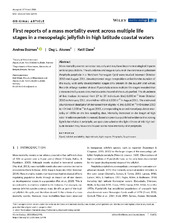First reports of a mass mortality event across multiple life stages in a mesopelagic jellyfish in high latitude coastal waters
Peer reviewed, Journal article
Published version

Åpne
Permanent lenke
http://hdl.handle.net/1956/19913Utgivelsesdato
2018-04Metadata
Vis full innførselSamlinger
Originalversjon
https://doi.org/10.1111/maec.12498Sammendrag
Mass mortality events can occur naturally and may have important ecological impacts on local populations. The abundance and stage structure of the coronate scyphozoan Periphylla periphylla in a Northern Norwegian fjord were studied between October 2010 and August 2011. Developmental stage composition varied for the duration of the study, with early developmental stages only present in the autumn and winter. Records of large number of dead P. periphylla across multiple life stages revealed that a mass mortality event occurred towards the end of the study period. The abundance of live medusa increased from 27 to 39 individuals (ind.)·1,000 m–3 from October 2010 to February 2011, then fell to <10 ind.·1,000 m–3 in August 2011. The estimated abundance of dead jellyfish increased from slightly >1 ind.·1,000 m–3 in October 2010 to >34 ind.·1,000 m–3 in August 2011, corresponding to an estimated population mortality of >80% on the last sampling date. Mortality increased as the length of high solar irradiance periods increased. Based on previous published evidence that strong light is harmful to P. periphylla, we speculate whether the light climate of this high latitude location may have contributed to the mass mortality of P. periphylla.
